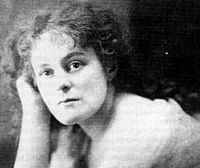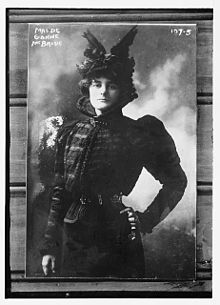- Maud Gonne
-
Maud Gonne 
Maud Gonne ca. 1900Born 21 December 1866
Tongham, EnglandDied 27 April 1953 (aged 86)
Clonskeagh, IrelandOccupation activist Spouse John MacBride Children Seán MacBride and Iseult Gonne Parents Thomas Gonne and Edith Frith Gonne (née Cook) Maud Gonne MacBride (Irish: Maud Nic Ghoinn Bean Mhic Giolla Bhríde, 21 December 1866 – 27 April 1953) was an English-born Irish revolutionary, feminist and actress, best remembered for her turbulent relationship with William Butler Yeats. Of Anglo-Irish stock and birth, she was won over to Irish nationalism by the plight of evicted people in the Land Wars. She was also active in Home Rule activities.
Contents
Early life
She was born at Tongham[1] near Farnham, Surrey, as Edith Maud Gonne, the eldest daughter of Captain Thomas Gonne (1835–1886) of the 17th Lancers, whose ancestors hailed from Caithness in Scotland, and his wife, Edith Frith Gonne, born Cook (1844–1871). After her mother died while Maud was still a child, her father sent her to a boarding school in France to be educated.
Political activity
 Maud Gonne McBride, no date. Library of Congress.
Maud Gonne McBride, no date. Library of Congress.
In 1882 her father, an army officer, was posted to Dublin. She accompanied him and remained with him until his death. She returned to France after a bout of tuberculosis and fell in love with a right wing politician, Lucien Millevoye. They agreed to fight for Irish freedom and to regain Alsace-Lorraine for France. She returned to Ireland and worked tirelessly for the release of Irish political prisoners from jail. In 1889, she first met William Butler Yeats, who fell in love with her.
In 1890 she returned to France where she once again met Millevoye. In 1891, she briefly joined the Hermetic Order of the Golden Dawn, a magical organization with which Yeats had involved himself.[2] Between 1893 and 1895, she and Millevoye had two children together named Georges and Iseult. Only the second, a girl named Iseult Gonne, born 1894, survived. (At age 23, Iseult was proposed to by then-52-year-old William Butler Yeats, and she had a brief affair with Ezra Pound. At age 26, Iseult married the Irish-Australian novelist, Francis Stuart, who was then 18 years old.)
During the 1890s, Gonne travelled extensively throughout England, Wales, Scotland and the United States campaigning for the nationalist cause. In 1899 her relationship with Millevoye ended.
Gonne, in opposition to the attempts of the British to gain the loyalty of the young Irish during the early 1900s, was known to hold special receptions for children. She, along with other volunteers, fought to preserve the Irish culture during the period of Britain's colonization.
I have always hated war and am by nature and philosophy a pacifist, but it is the English who are forcing war on us, and the first principle of war is to kill the enemy.[3]
Acting
In 1897, along with Yeats and Arthur Griffith, she organized protests against Queen Victoria's Diamond Jubilee. On Easter 1900, she founded Inghinidhe na hÉireann ("Daughters of Ireland"), a revolutionary women's society, to provide a home for Irish nationalist women who, like herself, were considered unwelcome in male-dominated nationalist societies. In April 1902, she took a leading role in Yeats's play Cathleen Ní Houlihan. She portrayed Cathleen, the "old woman of Ireland", who mourns for her four provinces, lost to the English colonizers.
In the same year, she joined the Roman Catholic Church. She refused many marriage proposals from Yeats because she viewed him as insufficiently nationalist and because of his unwillingness to convert to Catholicism.[citation needed]
Marriage
After having turned down at least four marriage proposals from Yeats between 1891 and 1901, Maud married Major John MacBride in Paris in 1903. The following year, their son, Seán MacBride, was born. However, after the marriage ended, Gonne made allegations of domestic violence, including the molestation of her then 11-year-old daughter Iseult Gonne,[4] her husband returned to Ireland. Gonne and her husband agreed on the need for an end to their marriage but could not agree on the future of their baby boy. She demanded sole custody and the right to educate and bring him up, threatening MacBride that if he did not agree to this she would take a case against him for divorce. MacBride stood firm and a divorce case began in Paris. The only charge against MacBride that was substantiated in court was that he was drunk on one occasion during the marriage. A divorce was not given and MacBride got visiting rights to see his son twice a week at his wife's home. He exercised these rights briefly but decided to return to Ireland and never saw his baby boy again. Gonne raised the boy in Paris until her husband was executed in 1916. Then she felt that she could safely return to live permanently in Ireland.[5][page needed] John Waters has described this episode as an example of 'parent alienation syndrome'.[6][page needed]
John MacBride was a veteran who had led the Irish Transvaal Brigade against the British in the Second Boer War. MacBride was executed in May, 1916 along with James Connolly and other leaders of the Easter Rising. Yeats proposed to her once again in 1916, and she once again turned him down. She remained in Paris until 1917.
In 1918 she was arrested in Dublin and imprisoned in England for six months. During the War of Independence she worked with the Irish White Cross for the relief of victims of violence. In 1921 she opposed the Treaty and advocated the Republican side. She settled in Dublin in 1922.
Yeats's muse
Why should I blame her that she filled my days/ With misery, or that she would of late
Have taught to ignorant men most violent ways/ Or hurled the little streets upon the great.(from No second Troy, 1916)
Many of Yeats's poems are inspired by her, or mention her, such as "This, This Rude Knocking." He wrote the plays The Countess Cathleen and Cathleen Ní Houlihan for her. His poem Aedh wishes for the Cloths of Heaven ends with a reference to her:
I have spread my dreams under your feet; Tread softly because you tread on my dreams.
Few poets have celebrated a woman's beauty to the extent Yeats did in his lyric verse about Gonne. From his second book to Last Poems, she became the Rose, Helen of Troy (in No second Troy), the Ledaean Body (Leda and the Swan and Among School Children), Cathleen Ní Houlihan, Pallas Athene and Deirdre.
Autobiography
Maud Gonne MacBride published her autobiography in 1938, titled A Servant of the Queen, a reference to a both a vision she had of the Irish queen of old, Cathleen (or Caitlin) Ní Houlihan and an ironic title considering Gonne's Irish Nationalism and rejection of the British Queen.
Her son, Seán MacBride, was active in politics in Ireland and in the United Nations. He was awarded the Nobel Peace Prize in 1974.
She died in Clonskeagh, aged 86 and is buried in Glasnevin Cemetery, Dublin.
References
- ^ 1881 census, Rosemont School, Tormoham, Devon
- ^ Lewis, page 140
- ^ Gonne, Maud; Jeffares, A. Norman; White, Anna MacBride (1995). The autobiography of Maud Gonne : a servant of the queen. Chicago: University of Chicago Press. p. 115. ISBN 9780226302522. http://books.google.com/books?id=PyRDfSepAdUC&lpg=PR1&pg=PA115#v=onepage&q&f=false.
- ^ p. 286, Foster, R. F. (1997). W. B. Yeats: A Life, Vol. I: The Apprentice Mage. New York: Oxford UP. ISBN 0-19-288085-3
- ^ Jordan, Anthony J. (2000). The Yeats-Gonne-MacBride triangle. Westport. pp. ?. ISBN 9780952444749. http://books.google.ie/books?id=yHhbAAAAMAAJ&q=The+Yeats+Gonne+MacBride+Triangle+by+Anthony+Jordan&dq=The+Yeats+Gonne+MacBride+Triangle+by+Anthony+Jordan. Retrieved 2011-03-14.
- ^ Waters, John (2010). Feckers: 50 People Who Fecked Up Ireland. Constable & Robinson Limited. pp. ?. ISBN 9781849014427. http://books.google.ie/books?id=DmTjRgAACAAJ&dq=Feckers:+50+People+Who+Fecked+Up+Ireland. Retrieved 2011-03-14.
External links
Categories:- 1866 births
- 1953 deaths
- Burials at Glasnevin Cemetery
- Converts to Roman Catholicism
- English Roman Catholics
- English revolutionaries
- English stage actors
- Irish revolutionaries
- Irish stage actors
- People from Tongham
- Roman Catholic writers
- Artists' muses
Wikimedia Foundation. 2010.

